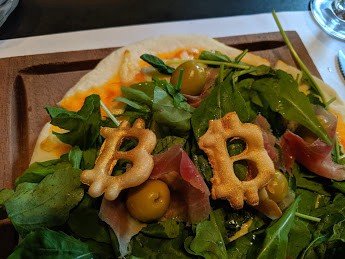On May 2010 Bitcoin was an incipient network formed by nerds, geeks, computer sciences hobbyists and techie libertarians. At the moment the mining was done on home computers or notebooks using the CPU to convert electricity into a worthless digital novelty collectible toy that could only be used to play around with. Users were mining it as well as sending the token back and forth using the only software available that did both the mining and wallet implementation.

The token bitcoin had no market value. It wasn´t being sold, just produced. So the market had a lot of supply but virtually no demand for it. The user NewLibertyStandard calculated the cost of producing one Bitcoin taking into account his electricity bill. Doing so arrived at the conclusion that 1,000 BTC was worth around 1 USD.
The block reward was 50 BTC, and both the difficulty and the total hashing power of the network were very low (in comparison to present times). This staged a perfect scenario to grab most of the around 7,200 bitcoins that were mined daily to anyone with the proper skills and mining power.
In this context, Laszlo Hanyecz invested his time, knowledge and skills to develop the necessary software to optimize the mining of an almost worthless token. He invented GPU mining. With this technology, he heavily improved the mining efficiency, increased his personal hashing and obtained lots of coinbase fresh produced bitcoins. At first, being the only GPU miner he had an enormous advantage over every other miner/user of the network. It´s estimated that he reached a point where he controlled up to 80% of the total hashing power. This led to a major personal increase of his BTC holdings when he could have hoarded several tens or even hundreds of thousands of coins.
“I’ll pay 10,000 bitcoins for a couple of pizzas.. like maybe 2 large ones so I have some left over for the next day. I like having left over pizza to nibble on later. You can make the pizza yourself and bring it to my house or order it for me from a delivery place, but what I’m aiming for is getting food delivered in exchange for bitcoins where I don’t have to order or prepare it myself, kind of like ordering a ‘breakfast platter’ at a hotel or something, they just bring you something to eat and you’re happy! I like things like onions, peppers, sausage, mushrooms, tomatoes, pepperoni, etc.. just standard stuff no weird fish topping or anything like that. I also like regular cheese pizzas which may be cheaper to prepare or otherwise acquire. If you’re interested please let me know and we can work out a deal. Thanks, Laszlo” — Posted on the 17th of May of 2010-

On the 22nd of May, the proposal was accepted, the pizzas were paid with a credit card and enjoyed by the Hanyecz family making it to Bitcoin history books.
Bitcoin pizza day is not about the man who gave away millions of dollars for a couple of pizzas, it is about how almost no one accepted millions of dollars for the price of a couple of pizzas. Price discovery is a messy and never-ending process. Subjective value appreciation changes over time. Anyone is willing to pay 41 USD for 10,000 BTC or even for 0.0051 BTC nowadays, but just a handful of people accepted Laszlo proposal for the pizzas and it took them five days to make the trade of their lives.
Subjective value appreciation is heavily influenced by social appreciation (and network effect). Hanyecz had to do the trade publicly and go against Gresham´s law spending hard money over soft one in order to show everyone that the tokens held real value. After doing so he completed a major milestone in Bitcoin history. The token ceased to be just a worthless novelty to become something new, undefined yet but with real value. After all, you can at least use it to buy pizza.
With this story in mind, if you are a holder you may want to think twice before spending it, and if you yet don´t have any bitcoin, as Satoshi said: “it might make sense just to get some in case it catches on.” –
– originally publish on May the 22nd 2019 by @camilojdl –